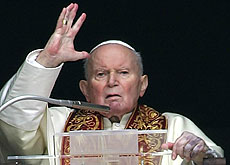
Pope John Paul II dies

Pope John Paul II has died at the Vatican, aged 84, after 26 years at the helm of the Catholic Church. Bells tolled in Rome to mark his passing on Saturday night.
The news of his death was immediately announced to thousands of people gathered in St Peter’s Square.
“Our Holy Father John Paul has returned to the house of the Father,” Archbishop Leonardo Sandri told the crowds.
Bells tolled across Rome, and flags were lowered to half-mast across the capital.
A Vatican statement said the Pontiff died at 2137 (1937 GMT) in his private apartment. He had asked not to be admitted to hospital, preferring to remain in his apartment.
The statement added that the succession procedures “Universi Dominici Gregis”, written by John Paul II on February 22, 1996, had been put in motion (see “The making of a pope”).
The Pontiff had been slipping in and out of consciousness throughout the day on Saturday, a Vatican spokesman said. His health deteriorated sharply on Thursday after he suffered an infection, and by Saturday his organs were failing, his blood pressure was low and his breathing was shallow.
He was given the last rites on Thursday. Since Friday, special masses have been held all over the world in the Pope’s honour.
Tributes
World leaders paid tribute to the late Pontiff on the news of his death. President Bush said he had been an inspiration to millions of Americans and others.
The Swiss president, Samuel Schmid, said the Pope had put his personal mark on the church, and had earned his papacy a place in history. He recalled the Pope’s visits to Switzerland and said a message of condolence would be sent to the Vatican.
Similar sentiments were echoed by the Swiss Bishops Conference, which also praised the Pope’s opposition to communism.
The United Nations Secretary-General, Kofi Annan, recalled meetings with the Pontiff during the war in Kosovo: “He … [was] extremely concerned about the world we lived in, and like me, he also felt that in war, all are losers.”
In the Pope’s homeland, Poland, Lech Walesa, former Polish president and Solidarity leader, remembered the Pope’s role in helping to bring an end to communism: “[Without him] there would be no end of communism or at least much later and the end would have been bloody.”
Outsider
The Polish Pope was regarded as an outsider when he was chosen to lead the church on October 16, 1978. At the time, few would have imagined that he would spend 26 years at the helm of the Church – the third longest tenure of any pontiff in history.
Apart from his opposition to communism, the Pope will be also be remembered for his uncompromising defence of traditional church doctrines, against contraception, abortion, easing celibacy rules and women priests.
Health problems
Worshippers have been holding vigils in St Peter’s Square since the Pope’s health became critical on Thursday. The Pontiff had been plagued with health problems for many years, but his condition deteriorated sharply in the past two months.
In February he underwent a tracheotomy to ease serious breathing problems, and never recovered properly from that operation. He was unable to address worshippers on Easter Sunday.
On Wednesday a feeding tube was inserted into his stomach in an attempt to boost his strength, but his condition rapidly deteriorated a day later when he developed a urinary infection and went into septic shock. By Friday, his organs were starting to fail.
Verifying death
The Vatican chamberlain formally verified the death, which in the past was done by tapping a pope’s forehead three times with a silver hammer.
The Vatican summoned the College of Cardinals, and the Vatican chamberlain destroyed the symbols of the pope’s authority: his fisherman’s ring and dyes used to make lead seals for apostolic letters.
John Paul’s funeral will be held within four to six days. The Vatican has declined to say whether he left instructions for his funeral or burial.
Most popes in recent centuries have asked to be buried in the crypts below St Peter’s Basilica, but there have been suggestions that the first Polish-born pope might have chosen to be laid to rest in his native country.
His successor will be chosen by a conclave of 117 cardinals, virtually all of whom were chosen by John Paul II himself. Observers say it is likely that his successor will continue to maintain a similar conservative line towards church doctrine.
swissinfo with agencies
In tributes, the Swiss president, Samuel Schmid, said the Pope had put his personal mark on the church, and earned his papacy a place in history.
President Bush said he had been an inspiration to millions.
The UN Secretary-General, Kofi Annan, said he “felt that in war, all are losers”.
The Pontiff died at 2137 (1937 GMT) in his private apartment.
The succession procedures “Universi Dominici Gregis”, written by John Paul II himself, have already been put in motion.
John Paul II was the third longest serving pope in history, having spent 26 years at the helm of the Catholic Church.

In compliance with the JTI standards
More: SWI swissinfo.ch certified by the Journalism Trust Initiative

























You can find an overview of ongoing debates with our journalists here . Please join us!
If you want to start a conversation about a topic raised in this article or want to report factual errors, email us at english@swissinfo.ch.